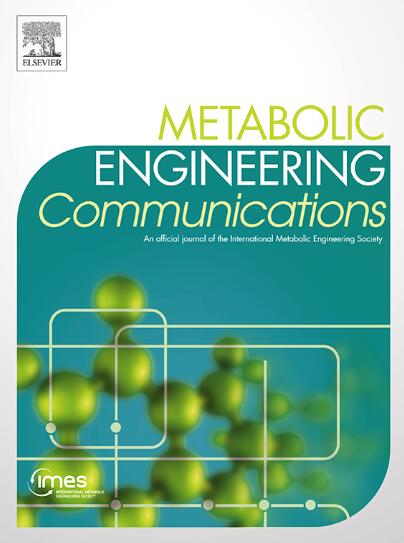下载PDF
{"title":"重组酿酒酵母代谢优化紫杉醇®前体生产","authors":"Behnaz Nowrouzi , Pablo Torres-Montero , Eduard J. Kerkhoven , José L. Martínez , Leonardo Rios-Solis","doi":"10.1016/j.mec.2023.e00229","DOIUrl":null,"url":null,"abstract":"<div><p><em>Saccharomyces cerevisiae</em> has been conveniently used to produce Taxol® anticancer drug early precursors. However, the harmful impact of oxidative stress by the first cytochrome P450-reductase enzymes (CYP725A4-POR) of Taxol® pathway has hampered sufficient progress in yeast. Here, we evolved an oxidative stress-resistant yeast strain with three-fold higher titre of their substrate, taxadiene. The performance of the evolved and parent strains were then evaluated in galactose-limited chemostats before and under the oxidative stress by an oxidising agent. The interaction of evolution and oxidative stress was comprehensively evaluated through transcriptomics and metabolite profiles integration in yeast enzyme-constrained genome scale model. Overall, the evolved strain showed improved respiration, reduced overflow metabolites production and oxidative stress re-induction tolerance. The cross-protection mechanism also potentially contributed to better heme, flavin and NADPH availability, essential for CYP725A4 and POR optimal activity in yeast. The results imply that the evolved strain is a robust cell factory for future efforts towards Taxol© production.</p></div>","PeriodicalId":18695,"journal":{"name":"Metabolic Engineering Communications","volume":"18 ","pages":"Article e00229"},"PeriodicalIF":3.7000,"publicationDate":"2023-11-15","publicationTypes":"Journal Article","fieldsOfStudy":null,"isOpenAccess":false,"openAccessPdf":"https://www.sciencedirect.com/science/article/pii/S2214030123000123/pdfft?md5=f48e8c4c1f2c289451094a6c748a04e0&pid=1-s2.0-S2214030123000123-main.pdf","citationCount":"0","resultStr":"{\"title\":\"Rewiring Saccharomyces cerevisiae metabolism for optimised Taxol® precursors production\",\"authors\":\"Behnaz Nowrouzi , Pablo Torres-Montero , Eduard J. Kerkhoven , José L. Martínez , Leonardo Rios-Solis\",\"doi\":\"10.1016/j.mec.2023.e00229\",\"DOIUrl\":null,\"url\":null,\"abstract\":\"<div><p><em>Saccharomyces cerevisiae</em> has been conveniently used to produce Taxol® anticancer drug early precursors. However, the harmful impact of oxidative stress by the first cytochrome P450-reductase enzymes (CYP725A4-POR) of Taxol® pathway has hampered sufficient progress in yeast. Here, we evolved an oxidative stress-resistant yeast strain with three-fold higher titre of their substrate, taxadiene. The performance of the evolved and parent strains were then evaluated in galactose-limited chemostats before and under the oxidative stress by an oxidising agent. The interaction of evolution and oxidative stress was comprehensively evaluated through transcriptomics and metabolite profiles integration in yeast enzyme-constrained genome scale model. Overall, the evolved strain showed improved respiration, reduced overflow metabolites production and oxidative stress re-induction tolerance. The cross-protection mechanism also potentially contributed to better heme, flavin and NADPH availability, essential for CYP725A4 and POR optimal activity in yeast. The results imply that the evolved strain is a robust cell factory for future efforts towards Taxol© production.</p></div>\",\"PeriodicalId\":18695,\"journal\":{\"name\":\"Metabolic Engineering Communications\",\"volume\":\"18 \",\"pages\":\"Article e00229\"},\"PeriodicalIF\":3.7000,\"publicationDate\":\"2023-11-15\",\"publicationTypes\":\"Journal Article\",\"fieldsOfStudy\":null,\"isOpenAccess\":false,\"openAccessPdf\":\"https://www.sciencedirect.com/science/article/pii/S2214030123000123/pdfft?md5=f48e8c4c1f2c289451094a6c748a04e0&pid=1-s2.0-S2214030123000123-main.pdf\",\"citationCount\":\"0\",\"resultStr\":null,\"platform\":\"Semanticscholar\",\"paperid\":null,\"PeriodicalName\":\"Metabolic Engineering Communications\",\"FirstCategoryId\":\"1085\",\"ListUrlMain\":\"https://www.sciencedirect.com/science/article/pii/S2214030123000123\",\"RegionNum\":0,\"RegionCategory\":null,\"ArticlePicture\":[],\"TitleCN\":null,\"AbstractTextCN\":null,\"PMCID\":null,\"EPubDate\":\"\",\"PubModel\":\"\",\"JCR\":\"Q2\",\"JCRName\":\"BIOTECHNOLOGY & APPLIED MICROBIOLOGY\",\"Score\":null,\"Total\":0}","platform":"Semanticscholar","paperid":null,"PeriodicalName":"Metabolic Engineering Communications","FirstCategoryId":"1085","ListUrlMain":"https://www.sciencedirect.com/science/article/pii/S2214030123000123","RegionNum":0,"RegionCategory":null,"ArticlePicture":[],"TitleCN":null,"AbstractTextCN":null,"PMCID":null,"EPubDate":"","PubModel":"","JCR":"Q2","JCRName":"BIOTECHNOLOGY & APPLIED MICROBIOLOGY","Score":null,"Total":0}
引用次数: 0
引用
批量引用


